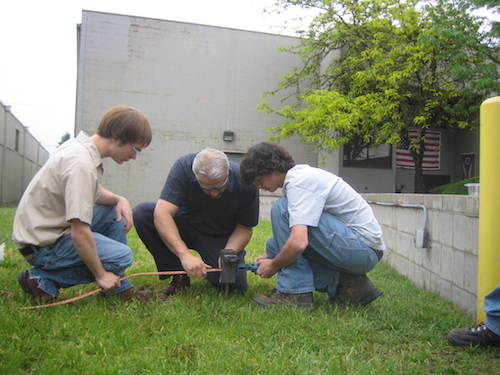Stephen Lipster, training director for Columbus, Ohio, Local 683, knows all about the aging of the IBEW’s construction workforce, but he’s not worried. Lipster is working with the next generation, and he’s seeing promising results.
In the next 12 years, 25 to 30 percent of the industry’s wiremen are expected to retire, says Lipster. Considering that it takes five years to train a new person, these numbers can be alarming. But every fall and spring, Lipster sees new faces interested in the electrical trades.

|
| Electrical trades programs like the one at South-Western Career Academy in Ohio are training the next generation of electricians. Photo courtesy of the Electrical Trades Center staff.
|
“At times it scares me,” says Lipster of the number of people leaving the field. “But school partnerships go a long way to meeting the needs of the industry. It’s a proven pathway.”
Those school partnerships involve the new electrical trades program at the South-Western Career Academy in Grove City, Ohio. The program, along with others in the Columbus area, trains high school juniors and seniors for a career in the electrical trades. Lipster says Ohio still has a very strong vocational school system, now known as “career-tech.”
Together with Fourth District Vice President Kenneth Cooper, Electrical Training Alliance Executive Director Todd Stafford and the National Electrical Contractors Association Eastern Region Executive Director Richard Parenti, Local 683 is piloting an initiative that uses the first year Electrical Training Alliance curriculum at the junior and senior high school level. Graduates from the South-Western program who are successful enrolling in the construction wireman program or the inside apprenticeship will be granted credit for their first year of apprenticeship curriculum. This credit also translates to 11 semester hours of community college credit through Columbus State Community College.
Lipster says that their student partner program has been running for 14 years, and that 40 percent of their current apprentices are former student partners.
“This pipeline has allowed us to shut down what once were nonunion hiring halls,” Lipster said of other training programs. “It has provided my union and employers with a quality supply chain of great entry-level workers. And these are workers who become leaders beyond apprenticeship.”
Considering the level of engagement the students get by hands-on training, it’s not hard to see why the programs are so successful. Students get acquainted with the field and to see if it’s a good fit. When it is, they can then begin exploring it more in-depth, all the while earning credit.
“This is a good program. We can look at performance on the job and get a better idea than we could from just an interview,” Lipster said. “They may not know what an electrician does before coming in, but they do when they leave.”
In addition to the semester-based classes, qualifying students may also participate in paid internships between their junior and senior years. During their senior year they take more advanced classes.
In an article for This Week Community News, Kevin Rankin, an instructor at the Electrical Trades Center, said that they are also finalizing plans to offer students an opportunity to spend time at companies in the electrical-trade industry during their senior year.
"Our plan is to offer a direct pathway for careers in the electrical industry," Rankin said.